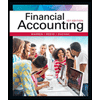
(a).
Concept Introduction:
The statement of retained earnings for year 1.
(a).
Concept Introduction:
Retained earnings: The retained earnings are the undistributed earnings during the year reported in the statement of retained earnings, the statement of retained earnings shows retained earnings, retained earnings increases with an increase in income and decrease with loss, withdrawal, and dividends.
The statement of retained earnings for year 2.
Want to see the full answer?
Check out a sample textbook solution
Chapter 1 Solutions
FINANCIAL AND MANAGERIAL ACCTG W/ACC CRD
- Alicia has been working for JMM Corporation for 32 years. Alicia participates in JMM's defined benefit plan. Under the plan, for every year of service for JMM, she is to receive 2 percent of the average salary of her three highest consecutive calendar years of compensation from JMM. She retired on January 1, 2024. Before retirement, her annual salary was $588,000, $627,000, and $666,000 for 2021, 2022, and 2023. What is the maximum benefit Alicia can receive in 2024?arrow_forwardABC Manufacturing Company produces widgets and has been operating for several years. The company's management team is responsible for preparing and monitoring the company's budget to ensure that it stays on track and achieves its financial objectives. ABC Manufacturing Company has recently completed its fiscal year. Management has compiled the planning budget and actual results for the year and has found that the company's actual performance fell short of its budgeted expectations. Management wants your help in gleaning extra information from what we have. The budget and actual results are as follows: Planning budget Sales revenue $5,000 Direct materials 1,000 Direct labor 1,500 Manufacturing overhead 750 Selling and administrative expenses 1,500 Profit $250 Actual results Sales revenue $4,500 Direct materials 1,200 Direct labor 1,100 Manufacturing overhead 900…arrow_forwardYou gave me unhelpful so i am also gave you unhelpful.if you will not give unhelpful then also i will not give unhelpful. what is accoun?arrow_forward
- Kling Company was organized in December Year 1 and began operations on January 2, Year 2. Prior to the start of operations, it incurred the following costs: Costs of hiring new employees Attorney's fees in connection with the organization of the company Improvements to leased offices prior to occupancy (10-year lease) Costs of pre-opening advertising Required: 1. What amount should the company expense in Year 1? 600 $3,000 12,000 6,000 5,000 Chapter 12 Homework assignment take frame Start-Up Costs What amount should the company expense in Year 2? +A $arrow_forwardI needarrow_forwardProvide correct solution and accounting questionarrow_forward
 Managerial Accounting: The Cornerstone of Busines...AccountingISBN:9781337115773Author:Maryanne M. Mowen, Don R. Hansen, Dan L. HeitgerPublisher:Cengage Learning
Managerial Accounting: The Cornerstone of Busines...AccountingISBN:9781337115773Author:Maryanne M. Mowen, Don R. Hansen, Dan L. HeitgerPublisher:Cengage Learning Managerial AccountingAccountingISBN:9781337912020Author:Carl Warren, Ph.d. Cma William B. TaylerPublisher:South-Western College Pub
Managerial AccountingAccountingISBN:9781337912020Author:Carl Warren, Ph.d. Cma William B. TaylerPublisher:South-Western College Pub Financial And Managerial AccountingAccountingISBN:9781337902663Author:WARREN, Carl S.Publisher:Cengage Learning,
Financial And Managerial AccountingAccountingISBN:9781337902663Author:WARREN, Carl S.Publisher:Cengage Learning, Financial AccountingAccountingISBN:9781337272124Author:Carl Warren, James M. Reeve, Jonathan DuchacPublisher:Cengage Learning
Financial AccountingAccountingISBN:9781337272124Author:Carl Warren, James M. Reeve, Jonathan DuchacPublisher:Cengage Learning Financial AccountingAccountingISBN:9781305088436Author:Carl Warren, Jim Reeve, Jonathan DuchacPublisher:Cengage Learning
Financial AccountingAccountingISBN:9781305088436Author:Carl Warren, Jim Reeve, Jonathan DuchacPublisher:Cengage Learning




